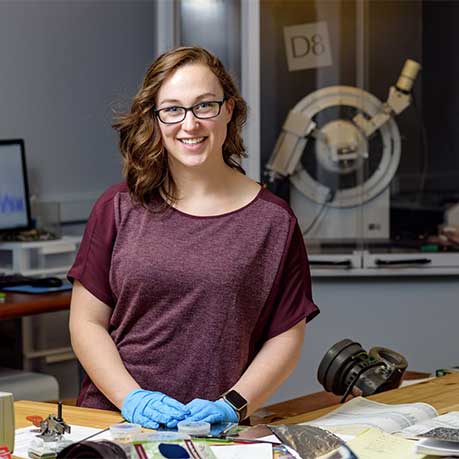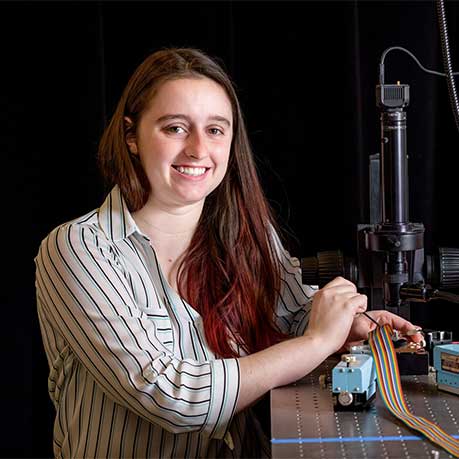Students’ Work Puts National Focus on RHIT Engineering Physics, Optical Engineering Programs

Kayla Storie
The research and laboratory experiences of engineering physics and optical engineering students Kayla Storie and Rebecca Swertfeger have made professional scientists and engineers, national college educators and prospective employers sit up and take note.
Nearly 4,000 hours of work in the campus’ microelectromechanical systems (MEMS) laboratory helped Storie earn a position as a process engineer supporting Intel’s cleanroom facilities in Chandler, Ariz.—a rare opportunity for a new bachelor’s-level graduate. She earned the best poster presentation award at the 2017 Conference for Undergraduate Women in Physics after making a groundbreaking discovery in micromachining.
Meanwhile, Swertfeger is spending this summer working on an optical component for the 2020 Mars rover during an internship at NASA’s Jet Propulsion Laboratory. She received an award for best student paper at the International Conference on Photonics in Portugal for past summer campus research in a NASA-sponsored communications project.
“Students are taking advantage of the Physics and Optical Engineering Department’s high-quality laboratory equipment and faculty expertise to make important inroads in their own scientific discoveries,” says Galen Duree, department head. “Rose-Hulman has established a solid reputation nationally and internationally in undergraduate optical engineering and physics, and our students and alumni continue to be our most valuable calling cards to our program’s continued success.”
Richard Liptak, assistant professor of physics and optical engineering, adds, “Few undergraduate students in the country come away with the wealth of knowledge in MEMS technology than those in Rose-Hulman’s engineering physics program.”

Rebecca Swertfeger
Through two years of research, Storie revealed that micromachining processes could place flexible electronic devices (transistors, capacitors and sensors) on clear thin plastic film—a discovery that could lead to substantial cost savings in the semiconductor industry. She also joined a group of classmates in showcasing their senior-year design project at the Directed Energy Professional Society’s Directed Energy Symposium in Huntsville, Ala. Due to Storie’s level of research and development expertise, high-tech companies throughout the country found it hard to believe she will be receiving “just” a bachelor’s degree this spring in engineering physics.
“Most people were shocked to learn, with my level of cleanroom experiences, that I wasn’t a master’s or Ph.D.-level student. I had to prove that I had experience well beyond what my year in school might suggest,” Storie says.
Swertfeger turned to the optical engineering program after starting her freshman year as a chemical engineering student. After taking a class on semiconductors, and with no laser experience, she was accepted to work with other students on a $500,000 NASA research project that continues on campus.
“The opportunity to become involved in cutting-edge work in incredible,” the senior says. “I can apply ideas and skills that I have learned in class to something that will make a difference in the world one day. I can see the outcome of my work, not as a grade, but as a product or idea that will actually be used. It’s incredibly rewarding to see a physical outcome of all of my hard work.”
Several graduate schools and companies are eager to procure Swertfeger’s skills after this summer’s NASA internship and her upcoming senior year of studies. She also has been able to begin professional relationships with several top professionals in optical engineering.
“I have found that it is rare to find undergraduate students with research experiences in optics, much less a paper under their name. Those opportunities have opened many career pathways for me,” she says.